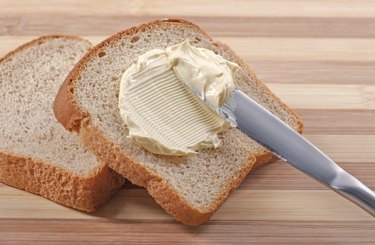
The United States Department of Agriculture sets recommendations for daily requirements of macro-nutrients such as carbohydrates, fats and protein as well as for vitamins and minerals. The Recommended Daily Allowance, or RDA, is intended to help people obtain adequate nutrition for health and wellness. The recommendations for daily fat grams depends on the type of fat, the age of the person and on how many calories that person consumes in a day. Not all fats are created equal. Limit your intake of harmful fats, specifically saturated and trans-fats, while focusing most of your dietary allowance of fat on mono- and poly-unsaturated fats.
Significance
Video of the Day
Fat is an essential macro-nutrient that helps hormone systems run smoothly, pads the internal organs, provides energy for the body and assists in the absorption of certain vitamins. Fat, as a macro-nutrient, contains more calories than either protein or carbohydrates—nine calories per gram. Too much fat can lead to an overconsumption of calories and weight gain.
Video of the Day
Recommendations
The USDA recommends that healthy adults over the age of 19 consume between 20 and 35 percent of their daily calories from fat. Young children (ages 1 to 3 years) need as much as 40 percent of their daily calories to come from fat. If you eat a diet of 2,000 calories per day, ingest between 44 grams and 77 grams of total fat daily.
Types
The USDA and the American Heart Association qualify these fat recommendations in terms of types of fat. Less than 7 percent of total fat calories should come from saturated fat—meaning that if you are consuming 50 grams of fat per day, only 3.5 grams should come from saturated sources. Health experts place even greater restrictions on recommendations for intake of trans-fats—specifically, less than 2 grams of trans-fats should be consumed daily, or 1 percent of total fat calories. Focus on getting the remainder of your fat calories from unsaturated sources.
Warning
The body produces all the saturated fat it needs and thus does not need to consume it from outside sources. Much of the American diet, however, contains saturated fat. Animal fats (meat and butter) contain saturated fats in varying degrees—in general, the skin and dark meat of poultry, full-fat dairy and fatty cuts of beef and pork are the worst offenders. Palm and coconut oils also contain saturated fat and are often found in processed snacks. Trans-fat, a man-made product used to increase shelf stability of foods, is present in a lot of snack foods and fried products. Avoid products with "partially hydrogenated oils" on the ingredient list.
Misconceptions
People trying to lose weight often think eating less fat is the best way to drop pounds. Fat helps satiate you and keeps your energy stores up. Unsaturated fats contain essential fatty acids and can be found in fatty fish, nuts, olive and canola oils, and avocados. These are the "good" fats that enhance your health and make up the majority of your daily fat calories.